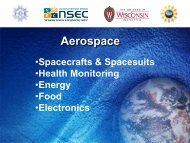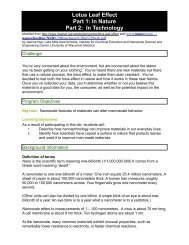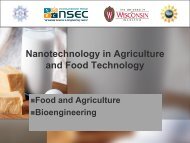Environment and Nanotechnology - Institute for Chemical Education
Environment and Nanotechnology - Institute for Chemical Education
Environment and Nanotechnology - Institute for Chemical Education
Create successful ePaper yourself
Turn your PDF publications into a flip-book with our unique Google optimized e-Paper software.
<strong>Nanotechnology</strong> <strong>and</strong> Oil Spills<br />
Deepwater Horizon oil rig exploded in the Gulf of Mexico on April 20,<br />
2010. What followed was an 87 day underwater leak of oil that wreaked<br />
havoc to aquatic life <strong>and</strong> human life. There are many proposed ways<br />
that nanotechnology can be applied to oil spill clean up, many of which<br />
are outlined at this link. Below is just one of many.<br />
• Researchers at MIT developed a mat of<br />
nanowires that can absorb up to 20 times<br />
its weight in oil.<br />
• After cleaning up oil from water, the oil<br />
can then be recovered by heating the<br />
membrane above the boiling point of the<br />
oil so that it evaporates.<br />
• The vapor can then be condensed back<br />
into liquid, <strong>and</strong> the oil AND the nanowire<br />
membrane can be used again!<br />
Top: Swatch of oil-absorbing nanowire<br />
mesh. Bottom: Scanning electron<br />
micrograph of the nanowire mesh.<br />
Photo credit: Francesco Stellacci, MIT,<br />
<strong>and</strong> Nature <strong>Nanotechnology</strong><br />
Resources [1] Thomson, E., “MIT develops a 'paper towel' <strong>for</strong> oil spills,” MIT News, http://web.mit.edu/newsoffice/2008/oil-paper-0530.html<br />
[2] Yuan, J. K., et al. "Superwetting Nanowire Membranes <strong>for</strong> Selective Absorption." Nature <strong>Nanotechnology</strong> 3.6 (2008): 332-36.













